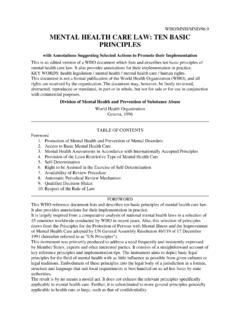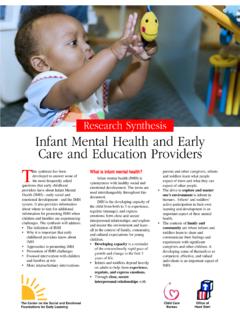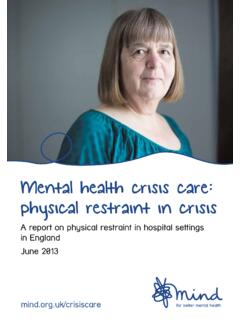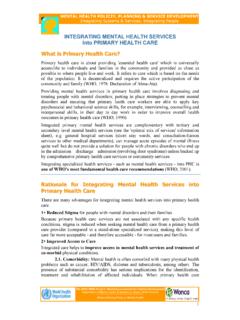Transcription of How Stigma Interferes With Mental Health Care
1 How Stigma Interferes with Mental Health CarePatrick CorriganUniversity of ChicagoMany people who would benefit from Mental Health ser-vices opt not to pursue them or fail to fully participate oncethey have begun. One of the reasons for this disconnect isstigma; namely, to avoid the label of Mental illness and theharm it brings, people decide not to seek or fully partici-pate in care . Stigma yields 2 kinds of harm that may impedetreatment participation: It diminishes self-esteem and robspeople of social opportunities. Given the existing literaturein this area, recommendations are reviewed for ongoingresearch that will more comprehensively expand under-standing of the Stigma care seeking link.
2 Implications forthe development of antistigma programs that might pro-mote care seeking and participation are also the quality and effectiveness of mentalhealth treatments and services have improvedgreatly over the past 50 years, many people whomight benefit from these services choose not to obtain themor do not fully adhere to treatment regimens once they arebegun. Stigma is one of several reasons why people makesuch choices; namely, social cognitive processes motivatepeople to avoid the label of Mental illness that results whenpeople are associated with Mental Health care .
3 A briefdefinition of Stigma is provided, followed by a more com-plete description of two specific manifestations that dis-suade people from treatment: the threats of diminishedself-esteem and of public identification when labeled men-tally ill. The article ends by briefly reviewing implicationsof these two factors for research and antistigma programsthat seek to increase consumer use of Mental important question throughout this article iswhether the problem of Stigma and adherence applies to thegeneric concept of Mental illness or differs by diagnosisand/or level of disability.
4 Research evidence on this issue ismixed. On one hand, research suggests there is a nonspe-cific label effect, implying that people labeled mentally ill,regardless of the specific psychiatric diagnosis or level ofdisability, are stigmatized more severely than those withother Health conditions (Corrigan et al., 2000; Weiner,Magnusson, & Perry, 1988). On the other hand, studiessuggest the public discriminates among psychiatric groupsin terms of Stigma ; for example, people with psychoticdisorders are judged more harshly than people with depres-sion or anxiety disorders (Pescosolido, Monahan, Link,Stueve, & Kikuzawa, 1999).
5 Moreover, treatment partici-pation and adherence seem to be greater problems in indi-viduals with psychotic disorders (Fenton, Blyler, & Hein-ssen, 1997). Given the equivocal nature of Stigma anddiagnosis, the relevance of specific diagnoses and disabil-ities is highlighted where appropriate in the remainder ofthis Health Problems and CareSeekingMost clinical and services researchers recognize severalinterventions as having sufficient empirical evidence tocommend them for treatment of specific disorders (Amer-ican Psychiatric Association, 1997, 2000; Gibbs & Gam-brill, 2002; Proctor, 2002; Torrey et al.)
6 , 2001). Two taskforces of the American Psychological Association(APA) on Psychological Intervention Guidelines (1995)and on Promotion and Dissemination of PsychologicalProcedures (1995) have developed standards for definingresearch evidence that describes empirically supported in-terventions. Division 12 members have summarized theseproceedings and similar efforts into a continually evolvingset of guidelines and recommendations (Chambless et al.,1996, 1998; Weisz, Hawley, Pilkonis, Woody, & Follette,2000). Chambless and Hollon (1998, p. 7) posed threequestions that perhaps best define evidence-based treat-ment:(a) Has the treatment been shown to be beneficial in controlledresearch?
7 (b) Is the treatment useful in applied clinical settings,and if so, with what patients and under what circumstances? (c) Isthe treatment efficient in the sense of being cost-effective relativeto other alternative interventions?As a result of ongoing clinical and services research, pro-viders and policymakers have developed evidence-basedguidelines that suggest specific treatments will improve thelives of people with particular problems and the plethora of evidence-based interventions,services researchers are familiar with two disconcertingtrends vis-a`-vis effective treatment: (a) Many people withmental illness never pursue treatment, and (b) others begintreatment but fail to fully adhere to services as epidemiologic research has provided evidencethat supports the first assertion.
8 Research from the Epide-Patrick Corrigan, Department of Psychiatry, University of concerning this article should be addressed toPatrick Corrigan, who is now at the Center for Psychiatric Rehabilitation,Evanston Northwestern Health care , 1033 University Place, Suite 450,Evanston, IL 60201. E-mail: 2004 American PsychologistCopyright 2004 by the American Psychological Association 0003-066X/04/$ 59, No. 7, 614 625 DOI: Catchment Area (ECA) Study showed that lessthan 30% of people with psychiatric disorders seek treat-ment (Regier et al., 1993). A subsequent large-scale study,the National Comorbidity Survey, showed similar results(Kessler et al.)
9 , 2001). Less than 40% of respondents withmental illness in the past year received stable these small ratios represent those with relativelyminor adjustment disorders who choose to withstand briefpsychological discomfort rather than engage Mental analyses of ECA data, however, do notsupport this assumption. Although somewhat better, thereis still concern about the number of people with seriousmental illness who do not receive care . About 40% ofpeople with such serious disorders as schizophrenia failedto obtain treatment (Regier et al., 1993), and people withserious Mental illness were no more likely to participate intreatment than those with relatively minor disorders (Nar-row et al.
10 , 2000). A national survey conducted by theSubstance Abuse and Mental Health Services Administra-tion found similar sobering results (Willis, Willis, Male,Henderson, & Manderscheid, 1998); fewer than 10% ofpeople with psychiatric disabilities receive such diagnosti-cally indicated services as vocational rehabilitation, casemanagement, or day treatment. Findings from a nationalsurvey conducted by the Schizophrenia Patient OutcomeResearch Team are also alarming (Lehman et al., 1998).Although more than 90% of individuals in the surveyreceived maintenance neuroleptic treatment, participationin evidence-based psychosocial treatments was far than half of survey participants reported participationin appropriate psychotherapies, less than a quarter wereinvolved in family therapy, and only about 10% receivedintensive case management.
















